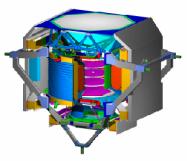The Adventure of Spaceflight
 AMS would be a much easier experiment on the ground. On the ground, we could build a magnet in a cheap aluminum vacuum case, plugged into an off-the-shelf cryo system for cooling. On the ground, we'd have a rack of desktop computers sitting next to AMS, spouting data directly to CERN via the internet. On the ground, we'd point ordinary fans and air-conditioners at our computers to keep them cool. On the ground, we would plug in a xenon bottle every few months to refill the gas system. On the ground, malfunctioning parts could be swapped out by two grad students armed with crescent wrenches. All of the engineering is easier on the ground.
AMS would be a much easier experiment on the ground. On the ground, we could build a magnet in a cheap aluminum vacuum case, plugged into an off-the-shelf cryo system for cooling. On the ground, we'd have a rack of desktop computers sitting next to AMS, spouting data directly to CERN via the internet. On the ground, we'd point ordinary fans and air-conditioners at our computers to keep them cool. On the ground, we would plug in a xenon bottle every few months to refill the gas system. On the ground, malfunctioning parts could be swapped out by two grad students armed with crescent wrenches. All of the engineering is easier on the ground.
In space, everything is hard. Some things seem impossible, but we have to do whatever it takes. It's a real adventure sometimes, but in the words of Apollo Mission Manager Gene Krantz "failure is not an option". Here is an outline of what AMS will go through over the next few years:
- Assembly AMS begins in bits and pieces, and it is a complicated matter to put them all together.
- Beam tests To calibrate and understand the detector, we use an accelerator to shoot particles through it. AMS should detect these particles just like it will do in space.
- Pre-launch In addition to testing its particle-detection capabilities, we need to test AMS's ability to survive and operate. Only when this is finished, we carefully and safely interface AMS with the Space Shuttle at Kennedy Space Center.
- Launch The most dramatic moment in the adventure of AMS: the Space Shuttle carries it aloft.
- Transfer to ISS Plugging AMS in to the International Space Station is an important maneuver.
- Talking to AMS We use the ISS's communications facilities to beam our science data back to Earth.
- Three (or more!) years in space AMS will be quiet but busy for three years, collecting cosmic ray data from its home on the ISS truss.
- The hostile environment Working in space is challenging, even for an autonomous robot like AMS; survival requires careful attention to temperature, radiation exposure, and unusual types of wear and tear.
- Monitoring AMS 24 hours a day, 7 days a week, a rotating team of AMS physicists will monitor the experiment from the ground.
- AMS science analysis We have to very carefully translate AMS's digital data into a simple list-of-particles; even more carefully, we have to translate that list into meaningful cosmic ray spectra and discoveries.
- After the mission AMS will not stay on ISS forever; after its mission, the Space Shuttle will bring it home ... for further adventures?
 AMS would be a much easier experiment on the ground. On the ground, we could build a magnet in a cheap aluminum vacuum case, plugged into an off-the-shelf cryo system for cooling. On the ground, we'd have a rack of desktop computers sitting next to AMS, spouting data directly to CERN via the internet. On the ground, we'd point ordinary fans and air-conditioners at our computers to keep them cool. On the ground, we would plug in a xenon bottle every few months to refill the gas system. On the ground, malfunctioning parts could be swapped out by two grad students armed with crescent wrenches. All of the engineering is easier on the ground.
AMS would be a much easier experiment on the ground. On the ground, we could build a magnet in a cheap aluminum vacuum case, plugged into an off-the-shelf cryo system for cooling. On the ground, we'd have a rack of desktop computers sitting next to AMS, spouting data directly to CERN via the internet. On the ground, we'd point ordinary fans and air-conditioners at our computers to keep them cool. On the ground, we would plug in a xenon bottle every few months to refill the gas system. On the ground, malfunctioning parts could be swapped out by two grad students armed with crescent wrenches. All of the engineering is easier on the ground.